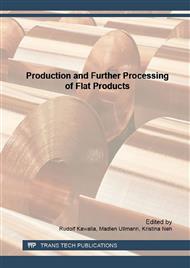[1]
R.P. Garrett, J. Lin, T.A. Dean, Solution Heat Treatment and Cold Die Quenching in Forming AA 6xxx Sheet Components : Feasibility Study, 8 (2005) 673–680. doi: 10. 4028/www. scientific. net/AMR. 6-8. 673.
DOI: 10.4028/www.scientific.net/amr.6-8.673
Google Scholar
[2]
M. Kumar, N. Sotirov, C. Chimani, Characterization of High Strength Al-Zn-Mg Alloy Sheet for Hot Stamping, Mater. Sci. Forum. 794-796 (2014) 796–801. doi: 10. 4028/www. scientific. net/MSF. 794-796. 796.
DOI: 10.4028/www.scientific.net/msf.794-796.796
Google Scholar
[3]
A. Falahati, E. Povoden-Karadeniz, P. Lang, P. Warczok, E. Kozeschnik, Thermo-kinetic computer simulation of differential scanning calorimetry curves of AlMgSi alloys, Int. J. Mater. Res. 101 (2010) 1089–1096. doi: 10. 3139/146. 110396.
DOI: 10.3139/146.110396
Google Scholar
[4]
A. FALAHATI, J. WU, P. LANG, M.R. AHMADI, E. POVODEN-KARADENIZ, E. KOZESCHNIK, Assessment of parameters for precipitation simulation of heat treatable aluminum alloys using differential scanning calorimetry, Trans. Nonferrous Met. Soc. China. 24 (2014).
DOI: 10.1016/s1003-6326(14)63327-6
Google Scholar
[5]
P. Lang, T. Wojcik, E. Povoden-Karadeniz, A. Falahati, E. Kozeschnik, Thermo-kinetic prediction of metastable and stable phase precipitation in Al-Zn-Mg series aluminium alloys during non-isothermal DSC analysis, J. Alloys Compd. 609 (2014).
DOI: 10.1016/j.jallcom.2014.04.119
Google Scholar
[6]
P. Lang, E. Povoden-Karadeniz, A. Falahati, E. Kozeschnik, Simulation of the effect of composition on the precipitation in 6xxx Al alloys during continuous-heating DSC, J. Alloys Compd. 612 (2014) 443–449. doi: 10. 1016/j. jallcom. 2014. 05. 191.
DOI: 10.1016/j.jallcom.2014.05.191
Google Scholar
[7]
J. Svoboda, F.D. Fischer, P. Fratzl, E. Kozeschnik, Modelling of kinetics in multi-component multi-phase systems with spherical precipitates I: Theory, Mater. Sci. Eng. A. 385 (2004) 166–174. doi: 10. 1016/j. msea. 2004. 06. 018.
DOI: 10.1016/j.msea.2004.06.018
Google Scholar
[8]
E. Kozeschnik, J. Svoboda, F.D. Fischer, Modified evolution equations for the precipitation kinetics of complex phases in multi-component systems, Calphad Comput. Coupling Phase Diagrams Thermochem. 28 (2004).
DOI: 10.1016/j.calphad.2004.11.003
Google Scholar
[9]
H.J. Rack, The influence of prior strain upon precipitation in a high-purity 6061 aluminum alloy, Mater. Sci. Eng. 29 (1977) 179–188. doi: 10. 1016/0025-5416(77)90125-2.
DOI: 10.1016/0025-5416(77)90125-2
Google Scholar
[10]
P. Sherstnev, P. Lang, E. Kozeschnik, Treatment of Simultaneous Deformation and Solid- State Precipitation in Thermo-Kinetic Calculations, Eccomas 2012. (2012) 8.
Google Scholar
[11]
U.F. Kocks, Laws for Work-Hardening and Low-Temperature Creep, J. Eng. Mater. Technol. 98 (1976) 76. doi: 10. 1115/1. 3443340.
Google Scholar
[12]
H. Stüwe, Dynamische erholung bei der warmverformung, Acta Metall. 13 (1965) 1337–1342. doi: 10. 1016/0001-6160(65)90045-3.
DOI: 10.1016/0001-6160(65)90045-3
Google Scholar
[13]
F.D. Fischer, J. Svoboda, F. Appel, E. Kozeschnik, Modeling of excess vacancy annihilation at different types of sinks, Acta Mater. 59 (2011) 3463–3472. doi: 10. 1016/j. actamat. 2011. 02. 020.
DOI: 10.1016/j.actamat.2011.02.020
Google Scholar
[14]
P. Lang, A. Falahati, R. Radis, M.R. Ahmadi, P. Warczok, E. Kozeschnik, Modelling the Influence of Cooling Rate on the Precipitate Evolution in Al-Mg-Si (Cu) Alloys, in: Mater. Sci. Technol. (MS&T), 16. -20. 10. 2011, 2011: p.284–291.
Google Scholar
[15]
M.R. Ahmadi, E. Povoden-Karadeniz, L. Whitmore, M. Stockinger, A. Falahati, E. Kozeschnik, Yield strength prediction in Ni-base alloy 718Plus based on thermo-kinetic precipitation simulation, Mater. Sci. Eng. A. 608 (2014).
DOI: 10.1016/j.msea.2014.04.054
Google Scholar
[16]
Y. Birol, Pre-straining to improve the bake hardening response of a twin-roll cast Al-Mg-Si alloy, Scr. Mater. 52 (2005) 169–173. doi: 10. 1016/j. scriptamat. 2004. 10. 001.
DOI: 10.1016/j.scriptamat.2004.10.001
Google Scholar


